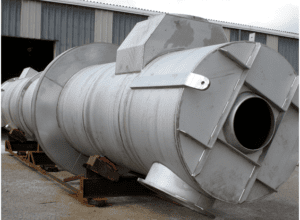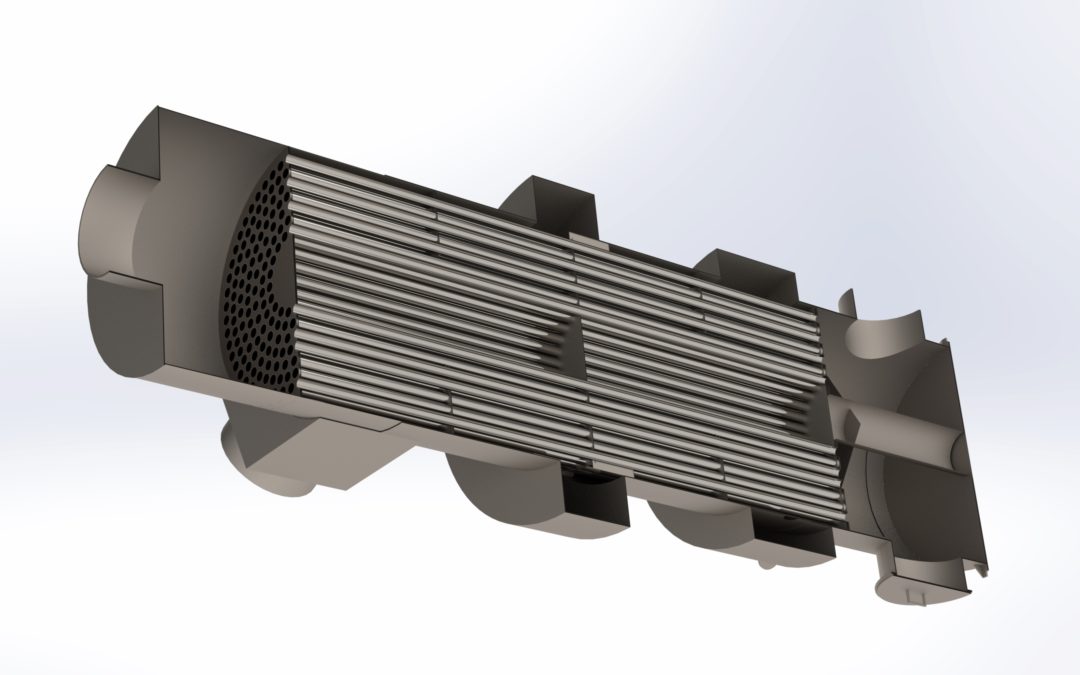Critical Design Considerations for High-Temperature Heat Transfer
 Avoid cold-end corrosion. The introduction of low-temperature air can result in cold spots within a recuperator, causing condensation of some constituents of the process gas stream. The resulting reaction between this corrosive condensate and the heat exchanger surface is commonly referred to as cold-end corrosion. To avoid this destructive mechanism, the equipment must be designed such that the metal temperature does not fall below the dewpoint anywhere within the heat exchanger. This can be accomplished with an experience-guided Computational Fluid Dynamics (CFD) analysis.
Avoid cold-end corrosion. The introduction of low-temperature air can result in cold spots within a recuperator, causing condensation of some constituents of the process gas stream. The resulting reaction between this corrosive condensate and the heat exchanger surface is commonly referred to as cold-end corrosion. To avoid this destructive mechanism, the equipment must be designed such that the metal temperature does not fall below the dewpoint anywhere within the heat exchanger. This can be accomplished with an experience-guided Computational Fluid Dynamics (CFD) analysis.- Avoid hot spots: When dealing with stream temperatures in excess of 1000F, it is particularly important to create a more uniform and symmetric temperature profile throughout the heat exchanger. In these higher-temperature applications, material choice will be dictated by the yield strength of a material at the design temperature. Again, through CFD analysis, areas of high metal temperatures or “hot spots” can be identified. Various design options can be employed to bring those temperatures in line with the metal temperature seen throughout the unit. This results in a low design temperature and avoids use of more costly materials.
- Eliminate stress failures. Temperature gradients across the tube bundle can lead to uneven stress concentrations at the tube-to-tube-sheet connections. These result in tubesheet failures with subsequent losses in production and costly repairs. These uneven stresses can be eliminated with proper tube layout and creative baffle and expansion designs.
- Reduce pressure drops. If the pressure drop is not properly determined, the design flow rate may not be maintained resulting in inefficiencies throughout the system. The pressure drop can be accurately determined with CFD. Unique baffle arrangements can be used when lower pressure drops are required.
- Maximize thermal efficiency. CFD is used to evaluate tube layouts and pass arrangements to create a symmetric design with optimal film coefficients and overall heat transfer rate. The resulting design requires less surface area and minimizes material and fabrication costs.
- Minimize maintenance downtime. In addition to the points already discussed, the potential for fouling can also be reduced by attending to the material temperatures; tube walls in particular.
In general, if the proper attention to detail is addressed during the design phase, common failure modes can be avoided, significantly improving productivity and reducing downtime.
High Temperature Heat Recovery

This recuperator heat exchanger is suitable for high-temperature gas such as process flue gas and other harsh streams. This includes those often found in acid manufacturing processes like sulfuric acid regeneration and production. Other common applications include high-temperature energy storage, steel mills and foundries, thermal oxidizers, production of green hydrogen, CO2 capture, and bioenergy recovery.
Key Components
All together, the AirBTU VPRR comprises specially engineered components developed to solve operational challenges like cold-end corrosion, hot spots, stress fractures, unexpected pressure drops critical to high temperature heat recovery. Its key components are:
- Baffle. The unique proprietary baffle design delivers multiple radial-flow passes on the shell side and is arranged to reduce tube wall temperature differences.
- Inlet and outlet piping connections. These connections on both the tube and shell sides can be positioned in any radial direction for ultimate installation flexibility.
- Tubes. All tube walls feature a symmetry in temperature to within 5%, facilitating uniform stresses throughout the tube-to-tube sheet connections. This significantly extends the exchanger’s lifespan. The precise mapping technique ensures wall temperatures are maintained above the acid dew point, eliminating the risk of cold-end corrosion. Or conversely, hot spots affecting material strength are avoided.
- The gas stream. Typically in a single pass, the gas stream passes from one end to the other within the tubes.
- Ambient intake or second gas stream. This enters the shell side and moves in a hybrid cross and counter flow pattern, with multiple passes.
- Vessel expansion joint. This is pre-compressed to allow near-neutral operation, minimizing operating stress at the tube-to-tube sheet connections.
Benefits of AirBTU VPRR
CG Thermal’s high-temperature gas-to-gas heat exchanger delivers unrivaled benefits that solve the challenges of high-temperature heat recovery. Its unique design prevents cold-end corrosion and fouling as well as stress fractures. In turn, it maximizes thermal efficiency and greatly reduces the likelihood of unanticipated pressure drops.
The AirBTU VPRR was designed to greatly reduce necessary maintenance and minimize downtime. It also contributes to lower operating costs by facilitating smaller pressure drops and higher thermal efficiency than competing models. Ultimately, its highly engineered design ensures operational success as well as a long operating life.
Applications
The AirBTU VPRR is suitable for sulfuric acid applications of up to +/- 1500 °F or 800 °C, including sulfuric furnace preheaters, wet sulfuric acid processes, contact sulfuric acid production, and more. It also offers a great solution for bio-energy recovery and CO2 capture.
Other applications include:
- High-temperature energy storage. It offers a reliable and efficient way to transfer the energy stored by media such as compressed air or high-temperature salts.
- Biofuel, Green hydrogen, and CO2 Capture. Recouping energy from fuel gas streams at temperatures that can exceed 1500 F to be utilized within the system or produce high-pressure steam.
- Thermal oxidizers. It preheats intake air using waste heat, removing VOCs from exhaust streams.
- Steel mills. It can preheat air for cooling gas streams used in environmental systems.
- Steel foundries. By retrieving heat from flue gases, the AirBTU VPRR can preheat combustion air for metal heat treatment furnaces.
Enhance Your Thermal Processes With Solutions From CG Thermal
CG Thermal creates process technologies for the harshest and most corrosive process streams. Our AirBTU VPRR eliminates operational problems like cold end fouling and corrosion, lowering operational costs and extending system lifespan. You can learn more about this technology on our website. To start a conversation about your equipment requirements, contact our team today.
Enhance Your Thermal Processes With Solutions From CG Thermal
CG Thermal creates process technologies for the harshest and most corrosive process streams. Our AirBTU VPRR eliminates operational problems like cold end fouling and corrosion, lowering operational costs and extending system lifespan. You can learn more about this technology on our website. Finally, to start a conversation about your equipment requirements, contact our team today.


